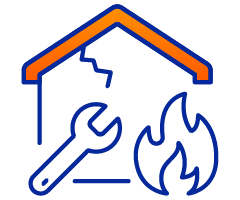Start Here
Homepage Bottom Form
We will get back to you as soon as possible.
Please try again later.
Permit and Inspection Checklist for Fire Rebuilds
🧱 Permit and Inspection Checklist for Fire Rebuilds
Created by House Fire Solutions – Helping Homeowners Rebuild Right, from Start to Finish
Rebuilding after a house fire isn’t just about construction — it’s about following every legal and safety step to protect your investment. Permits and inspections ensure your rebuild is safe, code-compliant, and fully approved for occupancy.
This detailed checklist walks you through every stage — from pre-application prep to final approvals.
🔥 1. Before You Apply for Permits
Before you can rebuild, you’ll need to handle the groundwork and gather documentation.
What to do:
- Request the official fire report from your local fire department — it’s required for insurance and permitting.
- Have the property inspected for remaining hazards (hot spots, unstable structures, or hazardous materials).
- Verify that your property’s zoning and land use still allow for residential rebuilding — especially if you plan any layout changes.
- Hire a licensed architect, structural engineer, or contractor to create stamped plans for submission.
- Confirm with your insurance adjuster that your rebuild plans match what’s covered under your policy.
- Take updated photos and videos of the property to document your starting point.
💡 Pro Tip: Organize all these documents in a physical binder or digital folder labeled “Permit Prep.” It’ll make the application smoother and faster.
🏗️ 2. Permits You’ll Likely Need
Each city or county may have slightly different requirements, but most fire rebuilds require the following:
- Building Permit: Covers the main structure, framing, roofing, and foundation work.
- Demolition Permit: Needed if you’re removing damaged materials or tearing down sections of the home.
- Electrical Permit: Authorizes rewiring, service panel replacement, and reactivation of electrical systems.
- Plumbing Permit: For replacing damaged water, sewer, or gas lines.
- Mechanical / HVAC Permit: Covers furnace, ductwork, or air system installation.
- Roofing Permit: Required for full roof replacement or structural repair.
- Grading or Tree Removal Permit: Needed if land reshaping or debris removal affects drainage or property lines.
- Solar or Generator Permit: If you’re reinstalling solar panels or adding backup power systems.
💡 Tip: Ask your contractor to double-check your city’s permit checklist — missing one permit can delay the whole project.
🧰 3. Pre-Construction Inspections
Before rebuilding begins, you’ll likely need a few key inspections. These ensure the property is clean, stable, and safe for new construction.
Inspections to complete:
- Site Safety Clearance: Confirms that debris, hazardous materials, and soot have been safely removed.
- Foundation or Soil Assessment: Ensures the ground or slab hasn’t been compromised by heat or water.
- Utility Disconnects: Confirms power, water, and gas are safely capped before construction starts.
- Temporary Power Setup: Approves installation of a temporary electrical pole or site service.
- Erosion or Drainage Check: Some counties require erosion control before new foundation work.
💡 Tip: Keep all inspection reports and email confirmations — you’ll need them for your final Certificate of Occupancy.
🏗️ 4. During Construction
Rebuilds typically require multiple in-progress inspections at each major milestone. These confirm that work meets safety and building code standards.
Common inspection points:
- Foundation Inspection: Reviews concrete, rebar, and anchor bolts.
- Framing Inspection: Checks stud spacing, structural integrity, and fire-blocking.
- Rough Electrical Inspection: Ensures wiring, breakers, and grounding are safe before walls are closed.
- Rough Plumbing Inspection: Tests for leaks, pressure, and venting.
- Rough HVAC Inspection: Confirms ducting, insulation, and vent placements.
- Shear Wall or Structural Inspection: Reviews tie-downs, bracing, and connections.
- Insulation Inspection: Verifies R-values and vapor barriers before drywall.
- Drywall or Fire Tape Inspection: Ensures walls meet fire resistance standards.
💡 Tip: Ask your contractor to schedule combination inspections (where possible) to save time and reduce scheduling delays.
⚡ 5. Final Inspections
Once construction is complete, several final inspections are required before you can legally move back in.
Expect the following final checks:
- Final Building Inspection: Verifies all construction matches approved plans and meets code.
- Final Electrical Inspection: Tests power systems, outlets, and safety features like GFCIs.
- Final Plumbing Inspection: Checks fixtures, water pressure, and proper drainage.
- Final HVAC Inspection: Ensures the system is running efficiently and safely.
- Fire Safety Inspection: Confirms smoke alarms, CO detectors, and clear access points.
- Certificate of Occupancy (CO): The final approval from your city or county confirming your home is safe and habitable.
💡 Tip: Your insurance company may require proof of the CO before releasing your final claim payment.
📋 6. After Approvals
Even after passing final inspections, there are a few key administrative steps to wrap up your rebuild:
- File copies of all permit approvals and inspection sign-offs with your local building department.
- Submit all final documents and receipts to your insurance adjuster for depreciation recovery.
- Update your homeowner’s insurance policy to reflect the new materials and systems installed.
- Keep all documentation safely — especially your new plans, CO, and inspection logs — for future home sales or refinancing.
- Consider a fire prevention follow-up inspection by your local Fire Marshal or safety consultant.
🔥 7. Optional Safety Upgrades (and Their Permits)
If you’re rebuilding anyway, it’s the perfect time to add modern fire-prevention upgrades:
- Install a residential sprinkler system.
- Upgrade to fire-rated drywall and insulation.
- Replace wood shingles with a fire-resistant roof.
- Seal attic vents to prevent ember intrusion.
- Hardwire interconnected smoke and carbon monoxide detectors.
- Use Class A roofing and non-combustible siding materials.
💡 Tip: Many of these upgrades require minor permits but can lower your insurance premiums significantly.
🧠 8. Common Mistakes to Avoid
- Starting rebuild work before permits are officially issued.
- Letting a contractor “handle permits” without seeing the approvals yourself.
- Failing to schedule mandatory mid-project inspections.
- Not keeping receipts and signed-off inspection forms.
- Assuming the insurance company will automatically cover permit fees (always confirm).
💡 House Fire Solutions Pro Tips
✅ Work with a
licensed contractor
familiar with fire rebuilds — they’ll know local inspection timelines.
✅ Create a simple
inspection log
to track what’s passed, what’s pending, and who signed off.
✅ Keep digital copies of every permit and inspection notice for both insurance and resale value.
✅ If you’re unsure about local requirements, contact your
building department
before starting work — they’ll gladly guide you.
💬 Final Advice
Every signature, every stamp, and every inspection brings you one step closer to your homecoming.
Follow this checklist carefully, and you’ll rebuild stronger, safer, and with peace of mind.
Our Team Helps You Navigate Insurance, Restoration, and Rebuilding
It is a long established fact that a reader will be distracted by the readable content of a page when looking at its layout.

Board-Up
Our Network of Board Up Specialist Will Secure your property fast

Temp Housing
We'll Help You Find Safe Shelter while you recover

Public Adjusters
Our Network of Fire Damage Adjusters Will Fight Help for a fair insurance payout

Investors
Our Partner Specializes in Buying Fire Damaged Homes So you Can Sell your home as-is

Content Cleaning
Restore what matters most

Restoration
Bring your home back to life

Attorneys
We have a network of Protect your rights and claims

Mental Health
Support for you and your family
Want To See If We Can Help You
If you'd like to speak with us today about purchasing Social Security, Personal Injury, Workers' Compensation or Employment Law Leads.
Homepage Bottom Form
We will get back to you as soon as possible.
Please try again later.